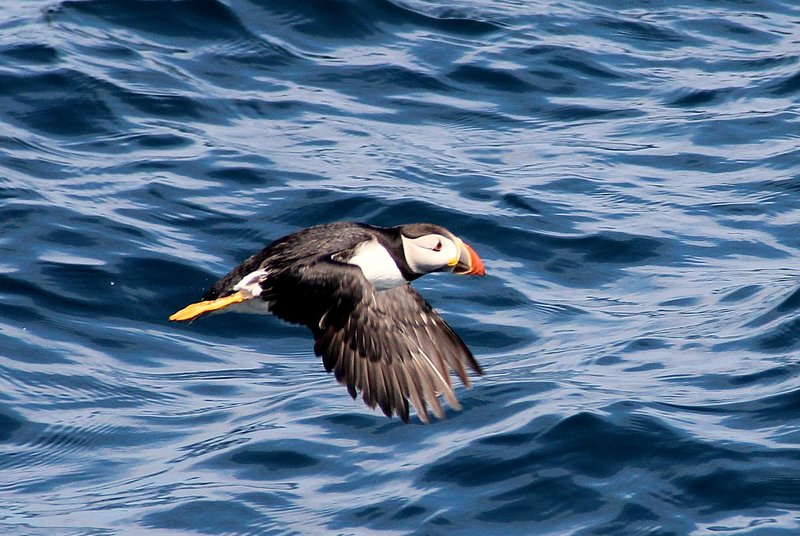Puffins in Ireland Best Season Time Place to see Puffins in Ireland

Video
July 4th, 2017 - Just One Month before Blasket Islands' Puffins Migrate back across the North Atlantic
The 12 inch long puffin ( Fratercula arctica - " little friar of the north" from their black and white monk-like habit) is perhaps one of the most recognisable birds in the Northern Hemisphere with its colourful blue, yellow and red striped beak, clown like facial expression, upright stance standing on its webbed orange-red feet, faltering take-off and landing techniques and waddling gait.
Blasket Islands and Skellig rock puffins come here to breed at the beginning of April and leave by the beginning of August, back towards the east coast of Canada (across the pond) and the mid-Atlantic ridge where they forage for the winter months on shoals of Capelin.
The Life of a Puffin
Puffins, like other Auks, can live into their thirties and do not begin to breed until they are about 5 yrs. old. During their adult lifetime they may take a one or two year break from the stress and routine of breeding. In common with other underground nesting birds they lay one whitish egg, as there is no need for camouflaging disguise, which takes about 40 days to hatch and then the "puffling" stays in the burrow for about another 40 days when the little fat puffling is then abandoned by its parents, until one night, under cover of darkness, it half-flies half-falls from the cliff into the waters below where it instinctively knows how to swim and fend for itself. Its parents may have abandoned it but they have imprinted its code for survival in its genes! This is unlike its cousin the Guillemot whose father accompanies the fledgling for the first few weeks of its life, which is always a pleasant sight to see as they swim along side by side on the water.
Enemies of the Puffin
Apart from man - the greatest enemy of all living avian, marine and terrestrial creatures and habitats - the puffin can only breed on offshore islands, sea cliff swards and grassy rocky scree slopes where there are no predators to raid its burrow and take its egg or chick. This is why it can only breed in areas where there are no rats, cats or American mink. During the breeding time it is preyed upon by the Great Black-backed Gull and the Skua and on the outer Blasket islands where they breed - Inishvickillaun, Inish na Bró, Tiaracht - The Western Isle - the Great Black-backed Gulls are constantly monitoring the puffin colonies waiting for an opportunity to seize and swallow an unwary one or harry a puffin returning to feed its chick with a mouthful of sand eels. Puffins can carry up to a record of 60 sand eels at any one time in their deep vertically compressed beaks which are rasped on the inside gape for extra grip.
Once they successfully navigate the dangers at the breeding colony they are relatively safe for the rest of the year on the wide Atlantic ocean billow where they feed on shoals of Capelin before returning again the following year to their lovely Blasket Islands home and breeding grounds.
AMERICAN MINK ON THE BLASKET ISLANDS S.P.A. [ SPECIAL PROTECTED AREA]
The biggest threat to the puffin population on the outer Blasket islands at the moment, as well as for other breeding seabirds like the Manx shearwater (Puffinus puffinus) who come here to breed from off the coasts of Brazil and Uruguay and the European storm petrel (Hydrobates pelagicus) who come here to breed from off the coast of South Africa, is the uncontrolled presence of American mink on the Great Blasket Island S.P.A. which anecdotal evidence suggest were deliberately introduced to the Great Blasket Island S.P.A. a few years ago.......
The fact that the Blasket Islands are an S.P.A. as well as a S.A.C. - both European designations - and there is no effective Wildlife Management Plan or Conservation / Protection Plan for the birds there supposedly protected under Eu legislation, shows the low esteem with which the protection of wildlife is held in Ireland, particularly for birds, even when required and obliged under EU legislation.
PUFFIN'S COUSINS AND RELATIVES - SOME EXTINCT
Other members of the Auk family are the Guillemot (Uria aalge); Razorbill ( Alca torda); Black Guillemot ( Cepphus grylle); Little Auk ( Alle alle); and the now extinct Great Auk (Pinguinus impennis) from whom the Europeans first gave the Antarctic "penguins" their name, as the great Auk was also flightless and of course thus defenceless against humans having neither the "fight or flight" response mode necessary to survive attack from humans.
Is it not time that we protect ( as obliged by EU legislation) the lives and habitats of the remaining auks (including puffins), Manx shearwaters, Storm petrels and Arctic terns that return annually to our Kerry shores and islands from the four corners of the world to breed and which we are privileged to view and share with our onboard visitors on our Eco Marine Tours around the lovely Blasket Islands and Dingle Bay?
Log of Whale Watch Tour Boat M.V. "Blasket Princess" Captain Whales Galore July 4th, 2017















